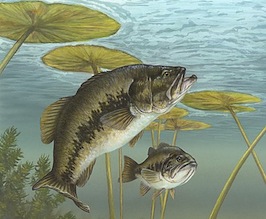
Largemouth bass are one of the most highly sought after gamefish in North America. This article will give you some information about largemouth bass including their appearance and size, habitat, and predation.
Largemouth Bass Appearance & Size
Largemouth bass are part of the sunfish family (Centrarchidae) and are the largest of all fish in the black bass group. Largemouth bass are olive-green in color with a black horizontal stripe that is comprised of several smaller black vertical stripes. They can grow up to almost 30 inches in length with a maximum record weight of approximately 25 pounds. The average lifespan for a large mouth bass is about 16 years.
Largemouth Bass Habitat
Largemouth bass were originally only found east of the Mississippi River. Due to their popularity as a gamefish, and with the aide of stocking programs, largemouth bass are now inhabiting freshwater bodies throughout all of North America. Largemouth bass are typically found in clear, quiet bodies of water and they prefer protective coverage such as vegetation, rock ledges, logs, and manmade structures such as docks.
Largemouth Bass Diet
Juvenile largemouth bass consume smaller baitfish, shrimp, and insects. Adult largemouth bass consume a wide variety of prey including smaller fish, crayfish, frogs, snakes, salamanders, bats, small water birds, small mammals, and even baby alligators! There is an interesting relationship between the amount of vegetative coverage in a water body and the growth rate of largemouth bass. If a waterbody has dense vegetative coverage a largemouth bass will grow more slowly overtime due to the difficulties of finding prey. Largemouth bass that forage for prey in clearwater bodies will grow more quickly as prey is more easily captured. The downside to this is that an overabundance of easily catchable prey can cause largemouth bass to decimate their food supply which will ultimately “shock” the fish stunting their growth.
Other Largemouth Bass Facts
- Biologists have identified two largemouth bass species, the Florida largemouth and the Northern largemouth.
- Spawning begins by age 3, and it’s the male largemouth that “stays home with the kids” until they are ready to leave the nest.
- Largemouth bass see in color for up to around 30 ft underwater!
- Largemouth bass literally have a sixth sense. It’s called the lateral line and it enables them to feel even the slightest of underwater vibrations.

One Reply to “Largemouth Bass Info”